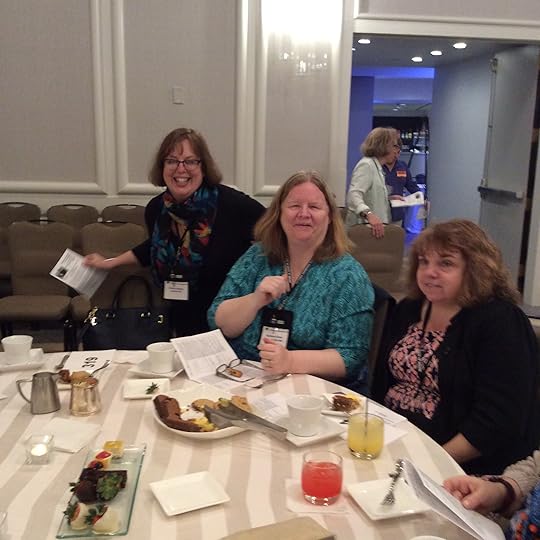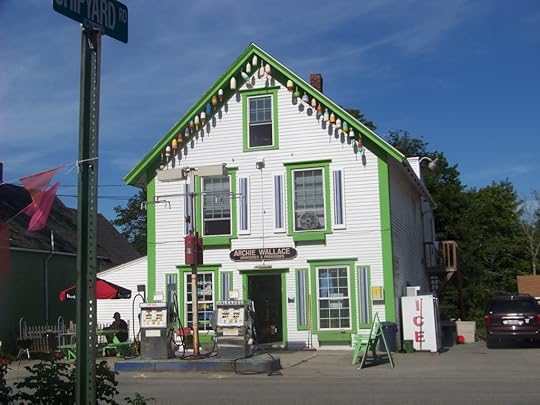Kathy Lynn Emerson's Blog, page 76
May 2, 2016
Clearing Clutter and Finding Gold
Kate Flora: It’s Monday morning and I’m due in a distant courthouse for Jury Duty in about an hour, so today’s post will necessarily be brief. It’s about my office–a subject we all dwell on from time to time. It’s really about the fact that I’ve been writing for almost 33 years. I’ve lost track, but I think I’ve now written about 24 books, and all the research, drafts 1-6, plus contracts, publicity, reviews, author photos, galleys, and the estate paperwork from my father, mother, and sister, are crowded into very small space. Yesterday, all that paper felt overwhelming, and I decided: Something must be done!
I spent many hours sorting through stacks of papers–hours that as of this writing are barely beginning to show despite two overflowing wastebaskets. The trouble with cleaning an office where so much creative work has taken place is that so many things are sentimental. Kind fan letters from readers who have discovered my work. Little notes in my mother’s handwriting, including a gargoyle saying “Happy Birthday.” A gargoyle? Seriously? But I am sentimental not about the gargoyle but the handwriting.
Under one of the desks, I find the briefcase my father bought me when I finished law school. It is now threadbare and ratty and I haven’t touched it in a dozen years. Keep, because of what it represents, or pitch because it no longer serves a purpose? I decide it can go. But a little farther on, there is my mother’s rolodex. She’s been gone ten years, but the names of the people, where they live, and her little annotations? It’s more like a storybook. I call my brother and ask what he things. “Throw it out.” It is still sitting in the undecided pile.
Then I grab what looks like an empty file, and inside are my earliest notes for my first published book, Chosen for Death. Amazing that I still have them all these years later, and in the stack, actually laminated to save it for posterity, the yellowing clipping from an Ann Landers column that gave me the idea for the book:
Dear Ann Landers:
A few days ago, a woman phoned and announced she was the daughter I had put up for adoption many years ago. She tried ro be nonthreatening and sounded like a nice person, but I was absolutely stunned. Old heartaches and fear overwhelmed me. She asked if I wanted to se her. When I said, “No,” she politely rang off. I sat by the phone shaking for 30 minutes.
I made a mistake when I was young, and I suffered for it. I never told a soul about the child I had. It was my intention to take the secret to my grave.
Can you imagine the pain of telling a thing like that to your husband, children, grandchildren, nieces and nephews and friends? I don’t think I could have lived through it.
Please advise people who assist in such searches to find another hobby. Inform those wrongheaded do-gooders who reveal confidential information that it is highly unethical and probably illegal, and it can do incalculable damage.
I can appreciate people’s curiosity about their biological parents, but I beg them to consider our right to keep this part of our lives secret. Although the woman who phoned seemed perfectly content to leave me alone, I have no assurance that she will. I now live in fear that she might appear at my door.
That telephone call has forever changed my life and robbed me of my peace of mind. No one has the right to visit this kind of hell on another person. Please so no, Ann.
Petrified in Iowa
From the column, I was able to create the collision of this woman, who had secrets to keep, and the daughter who longed to know why she was given up.
It made the whole day of cleaning worth it.
April 29, 2016
Weekend Update: April 30-May 1, 2016
 Next week at Maine Crime Writers there will be posts by Kate Flora (Monday), Maureen Milliken (Tuesday), Lea Wait (Wednesday), Kathy Lynn Emerson/Kaitlyn Dunnett (Thursday), and Barb Ross (Friday).
Next week at Maine Crime Writers there will be posts by Kate Flora (Monday), Maureen Milliken (Tuesday), Lea Wait (Wednesday), Kathy Lynn Emerson/Kaitlyn Dunnett (Thursday), and Barb Ross (Friday).
In the news department, here’s what’s happening with some of us who blog regularly at Maine Crime Writers:
This weekend Dorothy Cannell, Jessie Crockett, Kaitlyn Dunnett/Kathy Lynn Emerson, Barb Ross, and Lea Wait are at Malice Domestic. With luck, we can add more photos, but here is a start.
Shown below, uncaptioned, Kathy/Kaitlyn and Lea. Then Barb with Sherry Harris and Kim Grey all at the Friday evening charity auction/desert reception.

Kaitlyn’s auction item–the overflowing Scottie box
An invitation to readers of this blog: Do you have news relating to Maine, Crime, or Writing? We’d love to hear from you. Just comment below to share.
And a reminder: If your library, school, or organization is looking for a speaker, we are often available to talk about the writing process, research, where we get our ideas, and other mysteries of the business. Contact Kate Flora: mailto: kateflora@gmail.com
A Great Maine secret (and coming soon)
John Clark here. If you’ve followed the blog for any length of time, you are aware that there’s a connection between writing and gardening for several of us. Kate and I come by it naturally. Our father had a degree in horticulture and Mom was a garden writer and plant adventurer for years (she even has a tomato named Sennebec that she discovered in her garden).
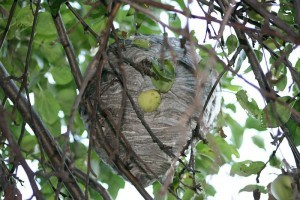
We couldn’t make the sale this year, so we grew our own
While I hated gardening as a kid (getting assigned weeding as your first plant related experience tends to do that), I’ve embraced it more and more as time has gone on. Last year, for example, I took on the enjoyable task of revamping and stocking my neighbor’s small flower garden across the street. This year, Beth and I agreed it was time to get a decent home greenhouse, so I looked around online and with son-in-law Russ’ help, have a really nice 8×6′ redwood frame greenhouse that’s full of seeds in containers ready to go.
When we moved to Hartland 13 years ago, one of my discoveries was the annual Fedco tree sale. Over the years, I have come to understand that it’s as much a cultural event as it is a great opportunity to get Maine hardy trees, vines, canes and organically grown set plants. The parking lot fills up early and quickly. Before it was moved to the current location, it was an adventure just to park as both sides of the rural road were lined with cars for half a mile in either direction. Since it moved to the present location (see link below) parking and access have gotten much easier.
http://www.fedcoseeds.com/trees/treesale.htm
It’s the kind of event where you see people you haven’t had a chance to chat with for ages, or get to know new and often interesting ones while waiting in line, learn about new varieties of fruits and discover ones you never knew grew in Maine. Several years ago, I bought twenty everbearing raspberry canes. They fruited the first year, doing so well I went back the next two years to get more. The third time, they were our of the red variety we liked, so I took a flier on Anne, a gold everbearing type that have turned into such a prolific producer we end up freezing much of the harvest and enjoy them in pancakes and ice cream smoothies all winter long.

Ultra sweet and big, big, big.
This year I’m going to be conservative. We have no more room for raspberries, but deer consumed one of the cherry trees I bought last year, so I’ll replace that and maybe add an apricot. The good news for you readers is that the sale is next Friday and Saturday, so that gives you time to take advantage of it. Here’s what Downeast Magazine said last year when they named the sale a Best Springtime tradition: “It’s just two days in late April or early May, but ever since 1984, the annual Fedco Tree Sale has been a red-letter event for Mainers with a green thumb. The Fedco warehouses just off I-95 in Clinton are filled with apple, peach, pear, plum, cherry, and nut tree saplings, plus blueberry bushes, rootstock, and vines, and close to 3,000 folks come from all over the state to shop and visit with friends they may not see again until the Common Ground Country Fair. It’s a rite of spring. 213 Hinckley Rd., Clinton. 207-426-9900. fedcoseeds.com”

So good you can have lunch while picking them come late July.
Hope to see some of you there, but if you want the best selection, go on Friday and browse the online catalog (http://www.fedcoseeds.com/trees/) in advance to create a wish list so you won’t be disappointed.
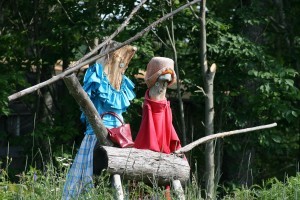
If you’re coming from the Eastport area, we’d love to hitch a ride.
April 28, 2016
Dream Vacation?
Jessie: Eagerly awaiting tomorrow’s start of the Malice Domestic Conference!
Everyone has an idea of their dream vacation. For myself and a lot of the writers I know, some of the best vacations involve attending writing conferences. I realise a working vacation is not everyone’s idea of a great time but I promise, for many of us it’s true.
Because our work is done in solitude, we have to seek out opportunities to interact with other people in our industry. Writing conferences function sort of like an office water cooler for us. Despite the fact that many of us would proudly claim the label introvert, we still enjoy spending time with people who have an idea of what it is like to be in this crazy business. In fact, when writers get together, most of us are having such a good time we are quite outgoing.
It does the heart good to talk with people who really understand why an agent requesting the first fifty pages of your manuscript is enough to keep you going for a couple more years. It is wonderfulto have the rare chance to compare notes about the writing process, craft, the state of the industry and how to reach new readers.
Putting faces to names is part of the fun too. Often writers have online correspondances with each other long before they meet in person. Having the opportunity to visit live with people you feel like your already know, but have never meet, is such a treat. Meeting readers, especially those who have commented on your blog posts, or have sent you fan mail, is truly wonderful.
There’s also the fun of star spotting. Conferences are full of other writers you respect and to whom you have written fan mail of your own. At conferences you can listen to them share their own stories from seats on panels or you may even be so lucky as to run into them in an elevator or at the bar.
So, if you ask a writer about their vacation plans, don’t be surprised to hear them gleefully replying they are headed for a long weekend of staying indoors and talking shop in a city not know for its tourism.
Readers, do you love to attend conferences in your industry? Writers, do you have favorite conferences you’d like to recommend?
April 26, 2016
The First RFD Carrier in Town
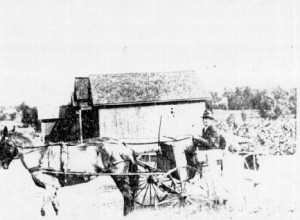
Fred Gorton on his RFD route
Kathy Lynn Emerson/Kaitlyn Dunnett here. What follows is not a Maine story, although I suspect similar events took place in this state. It is an account of my grandfather’s career working for the post office in rural Sullivan County, New York, an area that is geographically similar to central Maine.
Fred Gorton was the first RFD carrier in Liberty, New York. He started on March 2, 1908, when the whole idea of Rural Free Delivery was new. The mailmen, or carriers, who made $67.50 a month, provided their own horses and wagons and feed for the horses, too. In those early days, the RFD carrier usually worked from 10:30 until 4:30. Fred traveled a route twenty-seven miles long. At the end of the day he emptied all the mail he’d collected into a big tray in the post office in Liberty.
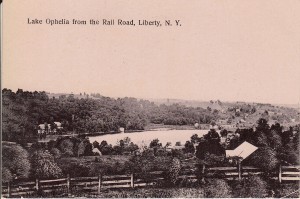 Fred had a horse named Old Dobbin for the first five years he worked this job. His first wagon had no top. He used an advertising umbrella for shelter. One day, Dobbin bolted and the umbrella sailed off into the air and landed in Lake Ophelia, never to be seen again. In the winter of 1910, Fred decided to drive Old Dobbin the whole length of Hilldale Lake on the ice in the hope of getting his name in the paper. In doing so, he skipped two boarding houses on his route. He never tried that again!
Fred had a horse named Old Dobbin for the first five years he worked this job. His first wagon had no top. He used an advertising umbrella for shelter. One day, Dobbin bolted and the umbrella sailed off into the air and landed in Lake Ophelia, never to be seen again. In the winter of 1910, Fred decided to drive Old Dobbin the whole length of Hilldale Lake on the ice in the hope of getting his name in the paper. In doing so, he skipped two boarding houses on his route. He never tried that again!
Fred knew all his customers by name and sometimes he was asked to play cupid. A new schoolteacher once asked him to deliver a sealed letter to her beau, but she warned him not to leave it in his mailbox, but to deliver it by hand. A man asked a similar favor. He was afraid his mother would see his love letters before he got home from work, so he asked Fred to leave them in a neighbor’s mailbox.
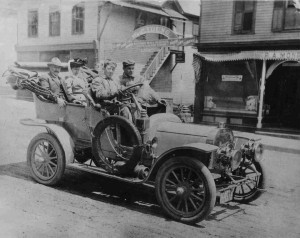
the first automobile in Liberty, New York with my maternal grandparents as passengers
In 1915, Fred bought at Model T Ford for $467.50. It came in a boxcar on the O&W Railroad. After two days of instruction, he drove it on his own. He had to crank it to start it, and when he had a blow out, he had to jack the car up, patch the inner tube, and blow it up again with a foot pump. Fred drove the Model T for three summers on the RFD route, but for four months every winter he still had to use a horse. They didn’t plow the roads in those day. From late December until mid-March, he hitched the horse to a sleigh.
Another horse Fred used on the RFD was named Roxy. He hired a livery horse every Thursday to spell her, but she made the trip five days a week nearly all winter. Some days he could use the horse part way, leaving her with someone while he made another loop through the fields and coming back again for her when he was done. One day he caught the train at Taylor’s Crossing and rode it back to Liberty with the mail.
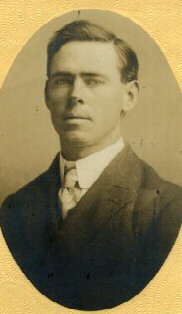 On February 19, 1916, Fred had the most difficult trip of his career. The sleigh upset twice, and he lost all his horse feed in the field. Then, when Roxy wouldn’t stand up, he jerked on her reins and broke the turret off the harness. By the time he arrived at Alvin Brown’s house, the road was completely impassable. He put Roxy in Brown’s barn, put all the mail in a sack, and went on by foot. It was just after noon when he started out from Brown’s. He stopped for dinner at one house on his route and left mail for eight patrons there. Another patron met him with an ox sled, breaking the road for him, and several others offered him hot drinks and food. Finally, after all the mail was delivered, Fred returned to Alvin Brown’s. The Browns had unharnessed Roxy, so while they were hooking her up again, Fred rested and visited. He finally got back to the Liberty post office at 7:05 PM, so lame from walking that he felt it for two days. He’d walked seventeen miles over his RFD route in snow two feet deep.
On February 19, 1916, Fred had the most difficult trip of his career. The sleigh upset twice, and he lost all his horse feed in the field. Then, when Roxy wouldn’t stand up, he jerked on her reins and broke the turret off the harness. By the time he arrived at Alvin Brown’s house, the road was completely impassable. He put Roxy in Brown’s barn, put all the mail in a sack, and went on by foot. It was just after noon when he started out from Brown’s. He stopped for dinner at one house on his route and left mail for eight patrons there. Another patron met him with an ox sled, breaking the road for him, and several others offered him hot drinks and food. Finally, after all the mail was delivered, Fred returned to Alvin Brown’s. The Browns had unharnessed Roxy, so while they were hooking her up again, Fred rested and visited. He finally got back to the Liberty post office at 7:05 PM, so lame from walking that he felt it for two days. He’d walked seventeen miles over his RFD route in snow two feet deep.
All of my grandfather’s story, one of my earliest writing projects, is online as The Life of a Plodder: Fred Gorton’s 95 Years. The index page is here: Life of a Plodder
Kathy Lynn Emerson/Kaitlyn Dunnett is the author of over fifty books written under several names. She won the Agatha Award in 2008 for best mystery nonfiction for How to Write Killer Historical Mysteries and was an Agatha Award finalist in 2014 in the best mystery short story category for “The Blessing Witch.” Currently she writes the contemporary Liss MacCrimmon Mysteries (The Scottie Barked at Midnight) as Kaitlyn and the historical Mistress Jaffrey Mysteries (Murder in the Merchant’s Hall) as Kathy. The latter series is a spin-off from her earlier “Face Down” series and is set in Elizabethan England. Her websites are www.KaitlynDunnett.com and www.KathyLynnEmerson.com
April 25, 2016
A Walking Tour of Littlehope, Maine
Jen Blood here, taking a break from full-on immersion in the next novel to spend a little time at Maine Crime. THE DARKEST THREAD is technically the first book in a new series featuring K-9 search and rescue handler Jamie Flint, but it’s actually a spin-off of my Erin Solomon novels, where Jamie was first introduced to readers. Now that I’m back in that world so much these days, I thought it would be fun to give readers a glimpse into the locales that have served as inspiration.
As a writer, I don’t think I’m that different from most who make their living crafting fictional worlds. I get inspiration from the world around me: the people, the places, the views, the animals. Having grown up in Midcoast Maine, I was never short on inspiration; there are plenty of eccentric characters and picturesque destinations to go around in these parts. While Erin’s hometown of Littlehope, Maine, is technically fictional, most people from this area agree that the little fishing village seems awfully familiar. That’s because Littlehope is an amalgamation of a handful of towns around here, and many of the businesses mentioned are places I frequent…well, frequently. Here are a few of them.
THE LOYAL BISCUIT
In the Erin Solomon series, the go-to destination for Erin’s dog Einstein is the Loyal Biscuit — a super-cool, actual pet boutique owned by Heidi Vanorse Neal, with locations in Rockland, Camden, Belfast, and Waterville. My pup Killian gets most of his food from the Biscuit, and has become so hooked on their duck feet that I’m pretty sure some form of doggie crack is a main ingredient. Heidi and the Biscuit have won a whole parcel of awards, the store has its own treat line as well as a line of dog toys, and it has the best crew of workers this side of the Mason-Dixon line. Whether you live in Maine or are just visiting, a must-stop destination for any animal lover is definitely The Loyal Biscuit.
DORMAN’S DAIRY DREAM
Since it first opened in 1951, the little ice cream stand on Route 1 headed north toward Rockland has become a mainstay. Now, every April without fail the whole region waits with bated breath for the day when the Open sign returns at Dorman’s Dairy Dream and another season of amazing ice cream is upon us. They’re not open on Sundays and the lines are usually substantial, but no one seems to mind. I can still remember being sunburned and shivering after a long day at the beach, so sleepy I could barely keep my eyes open, standing in line waiting for my peppermint stick with chocolate sprinkles on a homemade waffle cone (which I actually, incidentally, had just this afternoon). When I was writing SINS OF THE FATHER, the second Erin Solomon novel, it seemed only natural that one of the places Diggs and Erin would hit on their way out of town would be Dorman’s.

Dorman’s Dairy Dream, as captured by artist Robert Colburn.
LITTLEHOPE
While it’s true that Littlehope is actually an amalgamation of a whole slew of towns here in Midcoast Maine, the original inspiration is a little fishing village on a peninsula at the end of Route 97 called Friendship. When I first started writing ALL THE BLUE-EYED ANGELS back well over a decade ago, I was house sitting regularly for a couple who lived in a cute little cape on Tamarack Lane. In fact, the character of Noel Hammond is loosely based on the guy I house sat for, and Noel’s house is a dead ringer for that cute little cape. The general store, the public landing at the bottom of the steep hill, and the side roads that follow the ocean are all taken from Friendship, as is its reputation as a tough, independent little town that makes the news every so often for its lobster wars and the occasional domestic dispute.
I always think it’s fun to learn more about the places my favorite writers have patterned their settings after. What are your favorite fictional towns, and the characters who walk their streets?
Jen Blood is author of the bestselling Erin Solomon mysteries and the upcoming Flint K-9 novels. You can learn more by visiting her website, at www.jenblood.com.
April 24, 2016
Have I Been Looking At Things Backwards?
 Vaughn Hardacker here: In 2002 I realized that there was more to writing than just sitting down and putting words onto a page. I had to learn the craft. One of the first things I learned was that every story, whether it a mystery/crime story, a romance, or even a children’s story must have as a bare minimum, two characters: a protagonist and an antagonist. I set out developing two characters for my first Houston/Bouchard novel, SNIPER. I started with my hero, AKA the protagonist, Michael Houston and then my villain, the antagonist.
Vaughn Hardacker here: In 2002 I realized that there was more to writing than just sitting down and putting words onto a page. I had to learn the craft. One of the first things I learned was that every story, whether it a mystery/crime story, a romance, or even a children’s story must have as a bare minimum, two characters: a protagonist and an antagonist. I set out developing two characters for my first Houston/Bouchard novel, SNIPER. I started with my hero, AKA the protagonist, Michael Houston and then my villain, the antagonist.
In an effort to refresh my knowledge of the craft, I started reading DRAMATICA: A New Theory of Story by Melanie Anne Phillips and Chris Huntley (available at dramatica.com). The one thing that immediately struck me was in their discussion on characters, they maintain that in any story there are several distinct types of characters: the main character, the protagonist, and the antagonist. They define each as:
Main Character: The player through whom the audience experiences the story first hand.
Protagonist: The prime mover of the plot.
Antagonist: The character diametrically opposed to the protagonist.
In many stories, the hero is a combination of main character and protagonist. When taken in the context of the definitions above it is possible to argue that in most cases (especially in mystery and crime/thriller fiction) the villain better fits the definition of the protagonist. It is the villain, not the so-called hero, who is the prime mover of the plot (this is possibly more likely in the thriller genre). It is the villain who acts first forcing, for one reason or another, the hero to react. Throughout much of the story it is the actions of the villain that are the prime movers of the plot.
A couple of examples:
In Bram Stoker’s classic romantic tale of horror, Dracula, it is the villain, Count Dracula who is the prime mover of the plot, not the hero, Doctor van Helsing. Dracula moves, van Helsing reacts.
In every James Bond thriller it is the villain (Dr. No, Ernst Stravo Blofeld, etc.) who acts first and Bond who reacts.
In each of the cases above, I would argue that it is the villain who is the true protagonist and the antagonist is the main character or the hero. Who in your story is the protagonist; who is your antagonist; and who is your main character?
________________________________________________________
Vaughn C. Hardacker’s latest thriller, BLACK ORCHID, was released by Skyhorse Publishing, Inc. in March 2016. Skyhorse has also placed is fourth thriller, WENDIGO, under contract. He lives in SAtcokholm, ME where he is currently working on several new projects.
April 22, 2016
Weekend Update: April 23-24, 2016
 Next week at Maine Crime Writers there will be posts by Vaughn Hardacker (Monday), Jen Blood (Tuesday), Kathy Lynn Emerson/Kaitlyn Dunnett (Wednesday), Jessie Crockett (Thursday), and John Clark (Friday).
Next week at Maine Crime Writers there will be posts by Vaughn Hardacker (Monday), Jen Blood (Tuesday), Kathy Lynn Emerson/Kaitlyn Dunnett (Wednesday), Jessie Crockett (Thursday), and John Clark (Friday).
In the news department, here’s what’s happening with some of us who blog regularly at Maine Crime Writers:
Lea Wait: Thursday evening, April 28, from 5 p.m. until 7 p.m. my husband Bob (with his paintings) and I (with my books and antique prints) will be at The Bee’s Knees (617 Colonial Avenue) in Norfolk, Virginia, talking about — what else? Painting and Writing. Hope to see some of you there! Then I’m heading to Bethesda, Maryland, to Malice Domestic, where Kathy Lynn Emerson, Barbara Ross and I will be on the “Murder in New England” panel Saturday afternoon April 30 at 2:00. Exciting week!
An invitation to readers of this blog: Do you have news relating to Maine, Crime, or Writing? We’d love to hear from you. Just comment below to share.
And a reminder: If your library, school, or organization is looking for a speaker, we are often available to talk about the writing process, research, where we get our ideas, and other mysteries of the business. Contact Kate Flora: mailto: kateflora@gmail.com
April 21, 2016
No Bystander Effect Here
By Brenda Buchanan
The April 10 headline yanked me into the story.
‘No hesitation’ as Maine man rescues mother, 2 kids from sinking car.
The heroes were a 60ish couple from Steuben, Leonard and Rosemary Wallace, who were doing a little early-season trout fishing at Fox Pond in Township 10 when a car went airborne at a sharp curve in Route 182 and wound up in the 48 degree water.

The car, underwater in Fox Pond
The vehicle missed the Wallaces by maybe a foot. Despite the close call they sprang into action. Leonard waded in until the pond reached his armpits, wrenched open the car’s rear door and somehow managed to free both children and their mother. He handed the kids off to his wife, who attempted to flag down passing motorists while struggling to get a 911 call to go through in a virtual cell phone dead zone. When no one stopped to assist, she fired up their Grand Am and dug out some blankets to keep the freezing family and her adrenaline-fueled husband warm until an ambulance arrived.
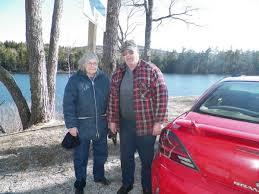
Rosemary and Leonard Wallace next to the pond where they saved three lives
The story got top billing in the media for several days, as did the unfortunate follow-up news that the mother—who was on her way home from getting treatment for her drug addiction—had been drinking. The Wallaces have since been honored by the Maine Legislature. The children were taken from their mother’s custody by the Department of Health and Human Services. I hope she gets the help she needs, which can be a complicated proposition, especially in Maine’s rural reaches.
Ten days later, I remain moved by the selfless heroism of the Wallaces. If I’d been sitting on that embankment that day, would I have dropped my fishing pole and jumped in after the sinking car? I’d like to think so, but until tested, who can say for sure?
Less than two weeks before the Black Woods Road incident I’d been pondering the same question from a different perspective.
Winston Moseley, the psychopathic serial killer convicted of the 1964 rape and murder of Kitty Genovese in Queens, New York, died on March 28. Moseley’s obituary recounted that numerous neighbors heard the middle-of-the-night assault but ignored the victim’s screams. That horrific part of the story didn’t become known until weeks later when the New York Times ran a sensational follow-up piece claiming 38 witnesses had turned their backs. That number later was found to have been exaggerated, but the fact remained that plenty of people heard and disregarded Kitty Genovese’s cries, a phenomenon that came to be dubbed “the bystander effect.”
In my books and those by some of my colleagues on this blog, non-cop characters tend to be more like the Wallaces and less like Kitty Genovese’s neighbors. When bad things happen, they dive right in.
Barbara Ross’s protagonist Julia Snowden doesn’t hesitate to get involved when trouble comes to Busman’s Harbor. Maureen Milliken’s Bernie O’Dea considers it her mission in life to wade into controversy and crime. Lea Wait’s Angie Curtis deserves a badge of her own for her crime-solving ways, and Dick Cass’s Elder Darrow (what a great character name, eh?) doesn’t let his troubled past deter him from investigating stuff the cops ignore. (Chris Holm, who delights in breaking rules, writes a protagonist who is neither cop nor crime-solver. His Michael Hendricks is a big-time crime-committer, albeit with a moral center.)
My newspaper reporter protagonist Joe Gale’s vigorous journalistic style inevitably pisses people off, which brings me back to the Maine road where Leonard and Rosemary Wallace saved three lives this month. Readers of this blog who’ve read Cover Story, the second Joe Gale novel, will know Route 182 by its local name—the Black Woods Road.

The Black Woods Road, which winds between Franklin and Cherryfield
In Cover Story, Joe Gale finds himself in big trouble on Route 182 during a January blizzard. With a fearsome antagonist riding his tail Joe skids around sharp curves in near-whiteout conditions—past the very spot where the young mother’s car flew into Fox Pond earlier this month—in a desperate effort to make it through the Black Woods alive.
After this month’s drama, I’ll never drive that road again without thinking of the courageous actions of Leonard and Rosemary Wallace, who saved a troubled Mom and her two babies from a tragic ending, a story Joe Gale and every real-life reporter in Maine would have shuddered to write.
Brenda Buchanan’s Joe Gale mysteries feature an old-school reporter with modern media savvy who covers the Maine crime beat. The first three Joe Gale books—Quick Pivot, Cover Story and Truth Beat—are available in digital format wherever ebooks are sold. Brenda can be found on the web at www.brendabuchananwrites.com, on Facebook at https://www.facebook.com/BrendaBuchananAuthor and on Twitter at @buchananbrenda
April 20, 2016
Writing What I Know … My Home’s History
Lea Wait, here. Stories of the past speak to me. Historical novels have always been among my favorites, and I write books set in nineteenth century Maine for ages eight and up in addition to my two mystery series, many of which have slices of history included, either as backstory or as clues to the solutions of murders today.
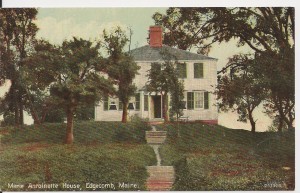
Photo Postcard of my home from 1900
What you may not know is that several of my books have direct connections to the history of the house I live in.
My home was built on an island in Maine in 1774 as a home for a Captain Decker and his wife and daughter. After the captain’s death his son-in-law, Captain Stephen Clough, bought the home, and lived there with his wife, his five children, and his mother-in-law. (In those days women couldn’t inherit property. But that’s another story!) Because of Jefferson’s Embargo, many captains, including Clough, lost their jobs. The house was left empty for a number of years as the family moved north in search of other ways to make a living. In the 1830s the house was briefly owned by a man who moved it (legends say twenty-yoke of oxen pulled it across the frozen river and up a steep hill) to the mainland. Shortly after that it was bought, in turn, by three different captains (all brothers), one of whom was a widower who married one of Stephen Clough’s granddaughters, bringing the house back into the original family. My family bought it in 1955.
So — what has that history to do with my books?
Sally Clough, the young sixteen-year-old bride in my Stopping to Home (1806), was the oldest child of my house’s second owner.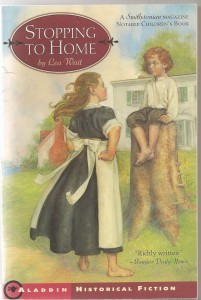
Reverend Adams, in Wintering Well (1819-1820), was the husband of one of Sally’s nieces.
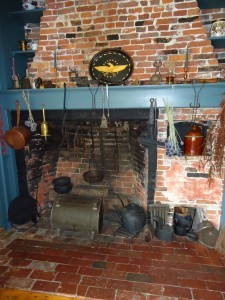
Lea’s Kitchen Fireplace
In Shadows on the Coast of Maine I tell the story of a house moved from an island to the mainland, and the original fireplace closed to make way for a modern stove. In the book my characters open that old fireplace and find … well, you’d have to read the book. But my mother and grandmother and I opened the wall in our kitchen and found … a lot of dirt, and the original crane in the fireplace.
In Living and Writing on the Coast of Maine I write more about the people who lived in this house; how they kept warm in the winter, and how the rooms in their house and ell and barn were used in the past.
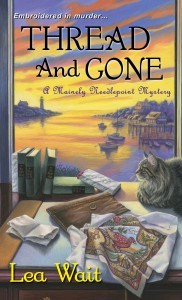 And in my most recent book, Thread and Gone, one of my main characters is a descendant of Captain Stephen Clough … and the mystery involves Clough’s involvement in trying to save Marie Antoinette, or other royalists, during the French Revolution. My historical notes explain what happened. My plot adds a few twists to the history.
And in my most recent book, Thread and Gone, one of my main characters is a descendant of Captain Stephen Clough … and the mystery involves Clough’s involvement in trying to save Marie Antoinette, or other royalists, during the French Revolution. My historical notes explain what happened. My plot adds a few twists to the history.
Are there more stories to be told connected to my home? Quite possibly. In (almost) two hundred and fifty years, a house hold many secrets and tells many tales. And a writer often writes about what she knows. Or imagines.
Lea Wait writes the Shadows Antique Mystery series and the Mainely Needlepoint series, and historical novels for ages eight and up set in nineteenth century Maine. For more information about her books, see her website.


